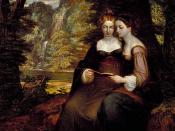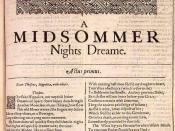�PAGE � Pascual � PAGE �1�
Pascual, James.
ENGL116
Professor Wing
7/19/2007
Essay #2: Explication of A Midsummer Night's Dream
Whether it's The Beatles, our boyfriends and girlfriends, husbands and wives or our own friends that confirm the validity of that statement, we know that to some degree, it's true. "All you need is love, love.. Love is all you need." We think about it, sing about it, dream about it and even lose sleep worrying about it. Love can be directed to not only one person but others, as well. Love can be shown for anyone and anything. In a nutshell, love is a rather short word, easy to spell, difficult to define but impossible to live without. In "A Midsummer Night's Dream", William Shakespeare presents a comedic but romantic interpretation of love in its various forms.
The play focuses on the idea of lovers finding one another and being free to marry, as represented by three unique couples: Theseus and Hippolyta, Hermia and Lysander and Helena and Demetrius.
Like all of Shakespeare's plays, the opening scene of the first act is of great significance because the main characters and basic conflict are introduced to the audience. In addition, they foreshadow how the play will progress. In the opening scene, the two couples are introduced and the conflict is set as Hermia's father Egeus forbids her to wed Lysander, her true love; instead, Egeus wants her to marry Demetrius, who is adored by Helena, Hermia's best friend. The opening scene of "A Midsummer Night's Dream" boasts many instances of elements of style that aid in the development of the play. Shakespeare's definitive and elaborate uses of diction, theme and characterization in the opening act/scene of "A Midsummer Night's Dream" prove to be essential...


